Modern surfboards come in all shapes and sizes. From longboards to shortboards, from beginner boards to big guns, from new experimental shapes to old retro designs, from your moms ironing boards to wooden house doors. These days we have more choice than ever. With so many different names, shapes, models…it gets hard to tell what is what, especially for beginners. We wouldn’t want you to really go out carrying an ironing board and calling it alaia, so what works where and for who – these is the ultimate complete surfboard type guide with all the main types of modern surfboards or maybe even better, lets call them wave riding vehicles.
NOTE: This is NOT exact science, some types overlap and morph into others as shapers are constantly experimenting with different shapes and designs and it is often impossible to draw a line between different models. Or at least pointless.
Table of Contents
Shortboard
Shortboards are generally meant for performance surfing, meaning spastic twisting and turning and jumping and making tricks. And barrels. There are many variations on this type of board so when someone says he rides a shortboard he just gave you the general outline of his board. Or even simpler – he said that his board has a narrower pointy nose. Shortboards can be ridden by surfers of different abilities, lets say advanced beginners (is this a level?) and better and in a wide range of surf conditions from knee high mush to a few times overhead waves. Of course within this range some boards are better for knee high mush and for surfers who suck and others for double overhead waves and ripping pros. Besides a pointy nose another characteristic is relatively low volume (compared to other surfboard types) which makes them unsuitable for complete beginners. Still – with more width and thickness the volume between various shortboard models varies quite a bit and helps put the board into “more volume/smaller waves/intermediate surfers” or “less volume/bigger waves/better surfers” category. The size of this board can vary from 5′ (1.5 m +) for young experienced surfers to over 7′ (2.lm) for bigger, heavier people. Most boards for people of average size and ability are around 6′-6’5″ long.

Thruster
Not so long ago all shortboards used to be called thrusters. Shortboard=thruster and thruster=shortboard. The terms were almost synonyms. The nickname thruster comes from the fin setup – three fin setup is called a thruster therefore a surfboard with three fins is also called a thruster. Since all (read 99.9%) shorboards used to have three fins you could use the name thruster for any shortboard you saw out there without looking like a fool. Today this is no longer the case and you can expect 0, 2, 3, 4 or 5 fins on a shortboard (usually 3 or 4) under that guys arm. So:”What kind of thruster is that?” is no longer acceptable. To be honest a 3 fin shortboard is still by far the most popular design but it used to be almost the only design worth mentioning when it came to performance surfing, these days the selection is wider. Whats the deal with three fins? This fin setup gives a combination of stability and drive (twin fin maneuverability + hold of single fins). GOOD: They work in wide range of conditions including steep walls and barrels. BAD: Water flow through the fins in not that smooth and you get drag when going straight. Who is it for? Everybody except complete beginners.

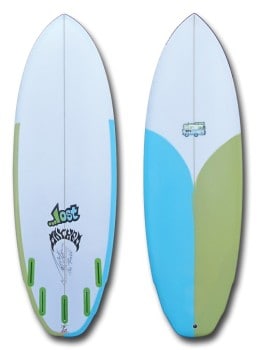
Quad
When we start talking quads and thrusters we are stepping into the fin setup territory and more is said about that in another article but since you will sooner or later hear the word quad thrown around referring to a surfboard and since we have just called a 3 fined shortboard a thruster here it is – a quad is a surfboard that has 4 fins. 4 fin setup is called quad and a surfboard with 4 fins is consequently also called a quad. There is a problem with naming surfboards by the number of fins – it is not necessary for a quad to be a shortboard. Actually same goes for thruster. So if someone is talking about a quad this is probably a 4 fin shortboard, but not necessarily:). Whats the deal with four fins? They give you more speed then 3 fins, the lack of center fin frees the water flow under the tail of the board. Two fins on each side working together also give you more hold in turns. So if you want speed, this is your setup. GOOD: Speed, hold and looseness. BAD: You have to get used to them and can slide out on late critical vertical drops (so they say). Who is it for? Everybody can surf a quad but surf it if you want more speed and loose feeling. Again – a quad shortboard is not for beginners of course because of the low board volume not because of the fin setup.
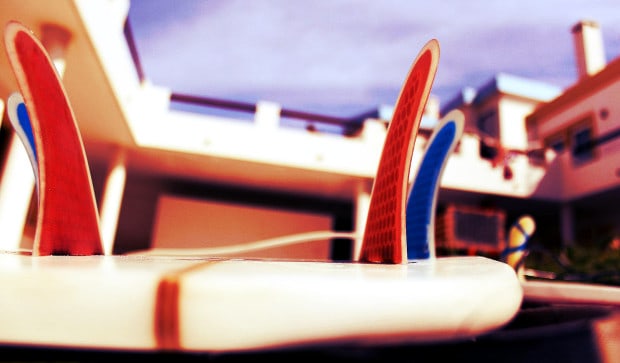
Bonzer
This is another fin setup found in shortboards and similarly sized wave riding vehicles and again a surfboard with this setup is also called a bonzer. Generally it is a 5 fin setup with 4 small sidefins and one larger center fin. But (there is always a but:) you can also have a 3 fin bonzer with small side fins and large center fin or a 5 fin bonzer with larger side fins and a small center fin (this small center fin is called nubster). The last one looks like a quad with small center fin and the first two look like this:
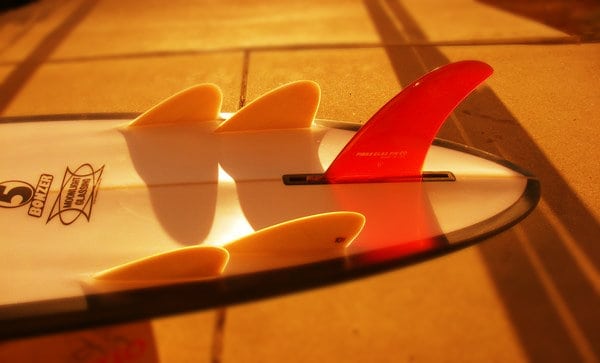
Whats the deal with bonzers? The general idea behind bonzers is directing water towards the tail. Bonzer5:”We have always looked at the water that escapes off the outside rail as unused energy.” Two long based side fins on each side together with cancave bottom deflect water from the rails and send it towards the back of the tail. This maximizes the use of the force that is created during turns and dramatically reduces drag. So bonzer originally is not only a fin setup, whole surfboard must be made into a bonzer. Who is it for? Read the description, maybe its for you:)? Not a very common board… Since this article is about surfboard types we don’t want to go too much into detail about fins, shapes, tail, bottom contours etc. If you are buying a surfboard you should also check how different surfboard parts influence the way the board rides.
Step Up Board
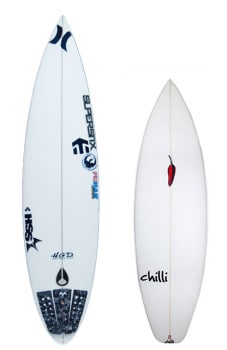
Step up and step down are not really surfboard ‘types’. They are an addition to surfers quiver relative to what he usually surfs. When the waves get bigger and harder to catch we need a board that is a little bit longer and possibly thicker to add some foam, volume and paddle power. We need a board that is a bit narrower so the rails hold better in more vertical walls and we need a board that has a thinner tail that again holds better in the face of the wave. This gives you more stability and control. In bigger waves this is what you need, you don’t need extra speed from wide templates – bigger more powerful waves will take care of that. So this is where a step up board comes in. It’s a board that is close to your everyday shortboard but a bit longer and more suitable for bigger stronger waves. A step up is usually 2-4 inches bigger than your regular shortboard. Then again – a question is what is your regular shortboard? If you ride an egg a longer egg is not a step up, if you ride a fish a longer fish is not a step up, and if you live somewhere where you surf bigger and more powerful waves every day then your regular shortboard is probably someone else’s step up. Confusing. Who is it for? Intermediate and experienced surfers.
Step Down Board
Same logic applies with step downs. When the surf is smaller and weaker that your average day then you will need a surfboard that is a bit shorter, wider and possibly thicker and better suited for powerless conditions. This is where a step down steps down (or in). It can be a bit confusing since recent shaping trend in shortboards is shorter and wider. Smaller wave shapes that also work in better surf conditions. So lots of people don’t ride ‘everyday shortboards’ anymore. Their everyday shortboard is already a stepdown. Anyway – if you ride a regular shortboard your step down will be 2-3 inches shorter. Who is it for? Step down indicates that you already have a regular shortboard so you are building a quiver. If you are building a quiver I would say you are at least an intermediate surfer:). Otherwise this board can be ridden by anyone except complete beginners.
Mini Gun / Semi Gun
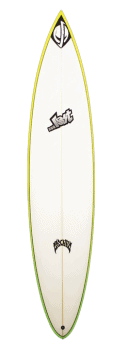
A semi gun is a surfboard designed for bigger waves. It’s a board that still works as a shortboard when it comes to maneuverability and as a gun when it comes to stability and control. Of course some sacrifices have to be made so a semi gun is not a board of choice for those biggest waves on the planet. Semi guns work in surf somewhere from 1.5x to 2x overhead. It is also a board of choice for steep hollow waves, powerful reefbreaks etc. What is a difference between a step up, mini gun and semi gun? There isn’t that much of a difference, boards get called step up/mini gun or step up/semi gun all the time. If you had to make a difference then a step up is usually the shortest – 2 -4 inches longer than your regular shortboard. A mini gun and a semi gun can be longer, from 4 to 12 inches longer than your everyday shortboard. One could also say that a mini gun is shorter than a semi gun but the definitions are quite foggy here. Who is it for? Intermediate and experienced surfers.
Gun
Guns are designed for seriously big waves. They are long (7ft and more) and narrow (around 18 inches) with plenty of thickness. Why? Bigger waves move faster so you have to paddle faster to match the speed of the wave and catch them – a longer board helps you with that. You need that volume to build momentum and push over the ledge. Narrow shape puts the rails of the board fully into the wave and helps them hold better. Same goes for the pointy pin tail. And a thicker board helps surfers navigate the chop on the wave when going straight. Big waves mean bigger speeds and small ripples on the face of the wave can kick the surfer off the board. When it comes to fin setup thruster is the most common, sometimes with a bigger center fin. Quads are also being used in the recent years. A few famous big wave spots:
- Jaws, Hawaii,
- Todos Santos, Mexico
- Maverics, California
- Dungeons, South Africa
- etc.
The key design features of these boards are related to survival rather than performance. Ease of entry to the wave, control whilst dropping (or sometimes free falling) into the waves, the speed to achieve these and successfully make the wave are the factors that dictate the gun’s design. You can’t surf a wave if you can’t catch it and drop in. I won’t explain much into detail here because I’m not a big wave rider and if you are looking for a big gun then you probably already know the stuff that I know. Instead here is a photo of Shane Dorian carrying his big wave board so you get some perspective. The thing is huge! Who is it for? Not for people reading about surfboard types on internet.
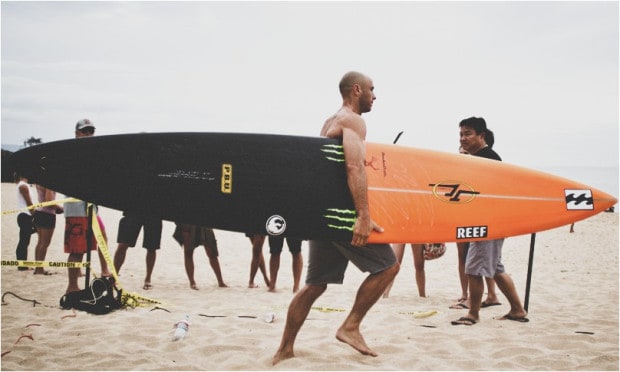
Rhino Chaser
Rihno chasers are also big wave surfboards. Is rhino chaser just another name for a big gun? Am..yes, but usually when saying rhino chaser you are thinking about those longest big guns out there for seriously big waves. Who is it for? For people chasing rhinoes (I though rhinos are protected species?).
Tow Board
Bigger waves are faster. When they get to a certain size they move too fast to be caught with just the power of surfers arms. Also – if waves are pitching, if they rise and break really fast then paddle surfer won’t have enough time to generate enough speed to catch the wave and to make the drop. So – it depends on the size and the type of the wave when paddling is no longer an option. Big wave paddle surfers are constantly pushing that limit though. Anyway, when you can’t paddle then you tow-in. Surfers get pulled into waves with a jetski and they use special tow boards for that. Since they don’t have to paddle to catch the waves all the extra length and volume is not necessary. Riding of the wave itself is easier with a shorter board, even though the wave is huge. With a giant surfboard it’s more about riding straight, with a smaller tow board you can actually ‘surf’ the big waves. One thing both boards have to deal with is chop. Since tow boards don’t have the length and the volume they would be pretty light and bumps on the face of the wave would throw them around like puppets. This is why they are loaded with weights making them really heavy and better for slicing through chop. Some tow boards also have straps so surfers can attach them to their feet. Really useful in placecs like Shipsterns, Tasmania.

Who is it for? For people that also ride guns and rhino chasers.
Hybrid
As the name tells you hybrid is what happens when a shortboard and a longboard make love. The shape of this board is somewhere between these two lovers but it is more on the shortboard side. Take a shortboard, make it a little bit longer and add some width to the outline (especially in the nose) and some thickness. The result is a board that has lots of volume and therefore more buoyancy. A board with more buoyancy is easier to paddle and easier to catch waves on. So a hybrid is a good choice for complete beginners, for beginners that have outgrown their first mini-mal/longboard and for surfers that are heavier/older/not so fit etc… Performance wise it’s an all purpose board that works in small and bigger surf. Fin setup is the same as with shortboards, usually a thruster or a quad. Typica measurements for a hybrid are length (6’6″ – 8’4″), nose width (14″ – 16″), center width (20″ – 22″), tail width (13.5 – 15″), and thickness (2.75″ – 3.25″). Who is it for? Beginners and bigger heavier surfers. Extra volume is not so great for duckdiving.
Egg
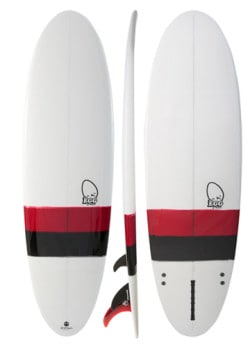
This board is round all around and kind of looks like an egg. Which is where it got its name. As I said at the beginning – board types morph from one into another so there is no need to complicate things – which board is an egg? If it kind of looks like an egg – its an egg. Shape-wise it is quite similar to a hybrid bot more on the longboard side. Wide, thick and usually longer than a shortboard. The main differences are that an egg will have less nose rocker (faster board) and the tail will be round (a rounded-pin is the most common) whilst a hybrid can have a square, squashed, swallow, round etc… tail. Another way of describing an egg is: “It’s a small longboard”. Usual fin setup is a single fin or a 2+1 thruster (large center fin, 2 smaller side fins). Typical dimensions? It can be from 6′-8′ long, over 20″ wide and over 2 1/2″ thick. Who is it for? It works best in smaller surf and since eggs have lots of volume and width they are good for beginners but intermediate and advances surfers will also have lots of fun riding them in small summer surf. Get an egg if you don’t care about performance surfing and tricks, if you want to slide over onshore conditions, mushy waves… have fun. And if you want to look alternative…(although in that case hurry up).
Fish

Term fish has many meanings and can cause some confusion. First it’s the name of the animal that swims in the Earths seas and rivers, then it’s the name of the surfboard and then it’s one of the names for surfboard tail. Coincidentally the name of the board comes from the similarity with the shape of the fish (animal) and this same board also has a fish tail, which is also called swallow tail or split tail. Fish (the animal) also has a fish tail. Fish is a shortboard that has a wider nose, a really wide split tail, usually low nose rocker and it’s very thick. This makes it a great alternative for for small waves since it is fast and easy to catch waves on. It flows over flat sections and helps you have fun in mediocre surf. It is also ok for turns but don’t expect it to turn like your shortboard. If you are used to riding shortboards then a fish can feel like a small longboard. Typical dimensions? Length from 5’4″ to 6’2″ for original fish, width up to 22″ and thickness from 2 1/4 to 2 3/4. Who is it for? Small and mushy wave surfers, beginners, people that like to experiment with their equipment, longboarders that want to make turns.
Hybrid Fish
An original old school fish (Lis Fish) is really wide and shorter than your shortboard, a modern style fish is narrower, can be longer (up to 8′) and is more shortboard oriented. The modern version is also called a hybrid fish.
Lis Fish
The original fish surfboard that was invented and shaped by Steve Lis. Boards that follow his shape are called Lis Fish. Steve Lis was actually a kneeboarder and designed this board as a kneeboard, but was subsequently ridden stand up by others. The differences between fishes and kneeboards is the wide point and the center of gravity of the board. The different between a Lis fish and a regular modern fish is in width. Modern ones are narrower, are usually not twin fins, have narrower tail ets…

Longboard (Mal)

Longboards were the original surfboards and the forerunners to the modern shortboard. They helped popularise the sport in the 1960’s but then almost disappeared in the late 1970’s with shortboard revolution. But these days longboards are back! Length, width and thickness gives them loads of volume. They are easy to paddle and easy to catch waves on. If you surf you will see longboarders sit a little bit further out because they can catch waves sooner when the waves are not that steep yet. They are great for: smaller days, having fun in weak waves, for older surfers with less stamina, for surfers the prefer the smooth glide and slow turns over shortboard tricks, for beginners learning how to surf (they are really stable), for experienced surfer in quality waves etc… Their downsides: slow maneuverability, a bit clumsy to carry around for weaker surfers, harder to get over whitewater on bigger days. Typical shape has a really wide and rounded nose and a wide tail (usually square tail or round pin). Typical dimensions? Length 8’6″ – 10’+, width 21″ – 24.5″, thickness 2.75″ – 3.75″. Who is it for? Surfers that prefer flow to tricks, hipsters, people with beards, overweight weekend warriors, locals from places with crappy waves, beginners.
Log
Some say ‘log’ is just another name for a longboardboard, some say a log is a heavily glassed longboard – meaning that it has thicker and heavier fiberglass layer, more lamination. That adds some extra weight and more durability. A heavier board also rides a bit differently but everything else is the same as with a regular longboard.
Mini-mal (Mini Malibu)
Mini-mal is, as the name implies, a smaller version of a longboard that is more maneuverable without sacrificing too much paddle speed and stability. And they are easier to carry around. Shapes are similar to longboard shapes – rounded nose, wide nose and tail, usually square tail or round pin. Typical dimensions? 7’2″ – 8’6″ ft long and 21″-22″ wide. Who is it for? Mini malibus are ideal boards for beginners and for longboarders who want a bit faster turning. If you want to learn how to surf and you are looking for a board, from all the boards on this page, get this one – get a mini malibu.
Funboard
Funboards are not really a distinctive type of boards. Hybrids, eggs, mini-mals are all considered funboards. It is a general term for all surfboards that allow you to catch a lot of waves because of the extra volume. Since they are wide and stable inexperienced surfers can also use them. Common points are a bit more length, more width, wider and rounder nose, wider tail, more thickness, more volume, less rocker… On the other hand, all surfboards should be called funboards. If you are not having FUN on your BOARD, then why surf at all? Typical dimensions? 7′-9′ long. Who is it for? Beginners & small summer surf surfers.
Aerial Board
Pro surfers can bust an air on any type of surfboard. Yes, even longboards. But an aerial surfboard is one that is intended for those small onshore days with short shorebreak sections and tiny closeout barrels. Shapers do make boards designed specially for busting airs but any smaller and lightweight shortboards will do. Highest air ever landed in competition? John John Florence in Oakley Pro Bali contest in 2013
https://www.youtube.com/watch?v=V_p9z6rgDzg
Alaia

An alaia is a piece of wood. OK, its more that that. Its a thin, straight, round-nosed, square-tailed surfboard inspired by boards from ancient Hawaii. A board from before there were surfboards. It has no fins and no rocker (the rocker kind of appears because the board is so thin that it flexes when you stand on it). The ancient version was between 7 and 12 ft long and made from the wood of Acacia koa. The modern version is made out of Redwood, Cedar, Pine, Balsa, and most commonly paulownia. Alaia is pain in the ass to ride. No wonder they disappeared when regular surfboards became available. Man ‘guilty’ for the alaia comeback is shaper Tom Wegener who began making alaias and testing them with pro surfers around the year 2006. Typical dimensions? Alaia can be from 5’ to 12’ long. Who is it for? People who surfed every day from when they were 5 years old and are a little bored with surfing. For the rest it’s kind of like working all year and then spending your vacation time on a 14 day surf trip to Iceland. Sounds fun but it’s a waste of time.
Planing Hull and Mini Simmons
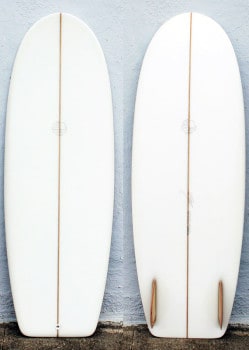
Robert Wilson “Bob” Simmons is called the father of the modern surfboard, he is known for many things but his main contribution was the application of objective hydrodynamic theory to the small planing hulls. A small planing hull is a surfboard. The result of his engineering knowledge were surfboards that were faster than anything ever made. This is why Simmons inspired surfboards are often called planing hulls and are still the fastest design out there. The revival of his shapes came with the movie called Hydrodynamica which is dedicated to his work. After the movie came out in 2002 boards shaped and used during the movie inspired other shapers and surfers and these days a mini Simmons is not that uncommon. A typical mini Simmons is somewhere from 4’10” to 5’6″ long, very wide at around 22″ and also very thick at around 3″. The original design has two fins but now other fin setups are also used. Who is it for? Speed freaks. It’s a great board for smaller conditions, it’s also ok for beginners to intermediate surfers since it has lots of volume but it is quite different board to ride. Finding yourself far out on the shoulder because the board is so fast is nothing to be surprised about:). Even though it’s short it’s quite hard to duckdive.
Softboard (Foamboard) and Softtop

These two are 100% for beginners. OK, it is true that Jamie O’Brien used a softboard to catch waves at Pipeline but it is also true that he is crazy and that the board quickly became foldable. Both these boards are shapewise more or less the same as a mini mal but a softboard is made out of foam and a softtop has…well….a soft top. Reason for this is safety. When you are learning how to surf, boards are flying around hitting you and people around you in the various parts of their anatomy and it hurts substantially less if you are hit by foam rather than by hard laminated surfboard. If it’s safe for a board to be soft it is not the best for its gliding ability. This is why softboards have a harder smoother bottom and why softtops only have a soft top. Typical dimensions? 7′-9′ long, wide round nose, wide tail. Who is it for? Clumsy beginners that go to surf schools. If you are a clumsy beginner don’t buy this board, you will get it in surf school. When you are done with the lessons buy a real surfboard. If you don’t believe the Jamei O’Brien bit, here is video proof:
Surfmat
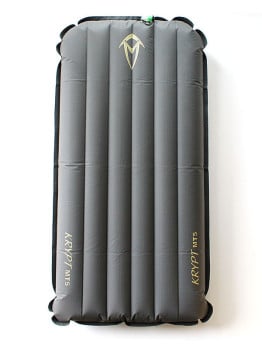
Hm…surfmat is an inflatable mattress designed for riding waves. Even though it can seem as a funny new idea surfmats have a long long beard. They are older than modern surfboards! First surfmats were developed in 1930’s in Australia and soon there was a surfmat boom all over the place. It was safe and fun, cheap and anyone could do it. Surfmats existed happily on the worlds beaches until Morey invented the boogie board. Then, in the late 60’s, early 70’s, the surf mat began to lose popularity. Today surfmats are almost non existent meaning you won’t find them on your average day out on the beach or in the lineup. But – there is a community of surfmat “shapers” and designers and with the retro revival lots of people are checking them out. And they all say it’s a really fun thing to do. Typical dimensions? Well, it’s a mat. Who is it for? Lazy people who rather lay down and think that bodyboard is not comfortable enough, history fanatics, people bored with shortboards, longboards and everything in between.
Kneeboard
Kneeboards and kneeboarders are almost extinct. I have seen like 2 maybe 3 kneeboarders in all my life. But it wasn’t always like that. Kneeboarding used to be really popular. In the 70s, lineups were full of them. They were kind of like today’s bodyboarders. On kneeboards people could make steeper drops, and fit into the tube more efficiently, the feeling of speed is greater… and at the time these boards were the stepping stones of progress. People developing kneeboards were always on the cutting edge using new materials, trying new shapes… The breakthrough for this board came with the release of the surf movie “Crystal Voyager” made by one of the legends of this sport, Californian, George Greenough. After those tube shots everybody wanted to ride a kneeboard.

The boards themselves are shorter and wider versions of surfboards and are specially designed to be ridden while kneeling. Their size ranges from 5 feet to 6 feet and a half (or sometimes even shorter) and are very similar to fish surfboards. Some have rubber coating on top to be easier on your knees. Their decline started with introduction of bodyboards. Typical dimensions? Length between 5′ and 6’5″, width 21″ – 23″, thickness 2 1/2″. Who is it for? Eccentrics, explorers of new ways of sliding down the wave.
Paipo Board
Paipo boards are inspired by old Hawaiian paipo boards which are one of the oldest if not the oldest wave riding vehicles out there. They and can be described as thin, lightweight boogie-boards. Or you could say they look like a food tray. They can be made out of wood or out of fiberglass. The difference between a paipo and a bodyboard is that paipo is harder, faster and more durable.
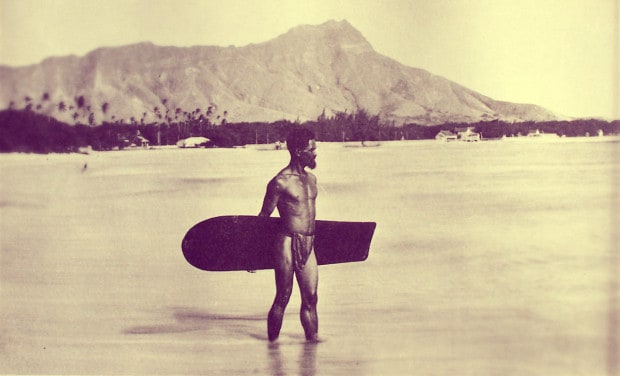
Typical dimensions? Around 40″ long and 30″ wide. Who is it for? Hardcore back to the roots bodyboarders. Picture says a 1000 words a video says I don’t know, 2000 words?
Bodyboard (Boogieboard)
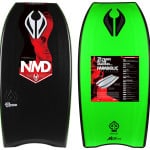
Bodyboards are soft short boards that are designed to be ridden lying down or on one knee (drop-knee). They are for beginners and children to get that sliding on the wave feeling but apparently there are also some grown men riding them :). They were invented by Tom Morey in 1970s (he called them boogie boards) and since they are safe and easy to use they have spread to the beaches all around the world. The average bodyboard is made out of rectangular piece of hydrodynamic foam either polyethylene foam or polypropylene foam. Better boards have one or two stringers that make then more durable and stiffer. You will also need swim fins if you intend to ride one. How to choose a bodyboard? Length is chosen on your height and weight. Width usually goes with length but wider board is more suitable for smaller waves and narrower for bigger ones (same as surfboards). Crescent and bat shaped tails are the most common in modern bodyboards. Crescent-type tails stick the board to the wave, while bat-type tails are more loose. Typical dimensions? Length between 36″ and 46″. Who is it for? Beginners, people who just want to have fun on the beach from time to time, people that want to ride heavy slab waves that are too fast for surfers, and people who for some reason don’t want to stand up, get a bodyboard and then try to stand up on it.
(Hydro)Foil Surfboard
First board of this kind was developed by water skier Mike Mack back in 1993. Laird Hamilton was the first surfer to ride it on a wave after being pulled by a jest ski. What exactly is a foil board? It’s a board with a metal rod that has wings attached to the bottom. When submerged these wings act kind of like airplane wings and lift the board out of water until only wings and part of the rod stay submerged. Result is less friction, higher speed and a ridiculous look! Higher speed translates into surfing waves that are not even breaking yet. Who is it for? Laird Hamilton.
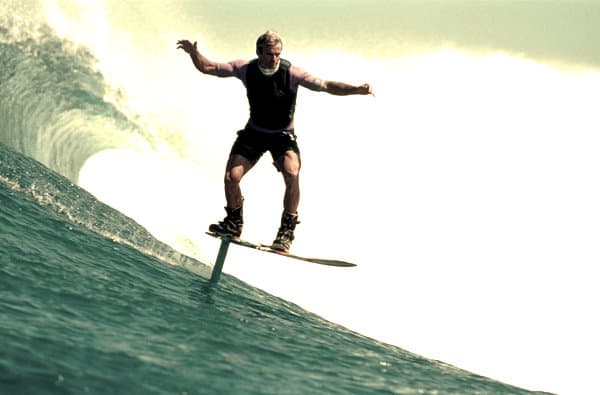
Skimboard
Here we are almost going out of the water…a skimboard is a wooden or fiberglass board without fins intended for sliding or better – for skimming over the water surface. By water surface I mean the thin water layer that comes up the sandy beach when a wave breaks. How does it work? You run along the beach, throw your skimboard on the water and jump on it letting the momentum take you for a ride. Better skimboarders use this water to slide into incoming shorebreak waves and ride them. Check out any ‘pro’ skimboard movie – it’s pretty insane:). Shapes: wooden skimboards are for flatland skimboarding as they are to heavy for riding waves, foam skimboards are lighter, float better and are designed for riding shorebreak waves. Who is it for? Kids playing on the beach, lunatics that enjoy being trashed into the sand.
Wooden Door
Typical dimensions? Length around 6’7″, width 3’3″. Who is it for? People bored with alaia.
http://www.youtube.com/watch?v=PCTqA_ov8RA
How Surfboards Are Made?
Most of the boards here can be made using different construction techniques. Hand shaped, machine shaped, PU core, EPS core, expoy resin, polyester resin, mold, pop-out, hollow boards etc… Check surfboard construction for more info.

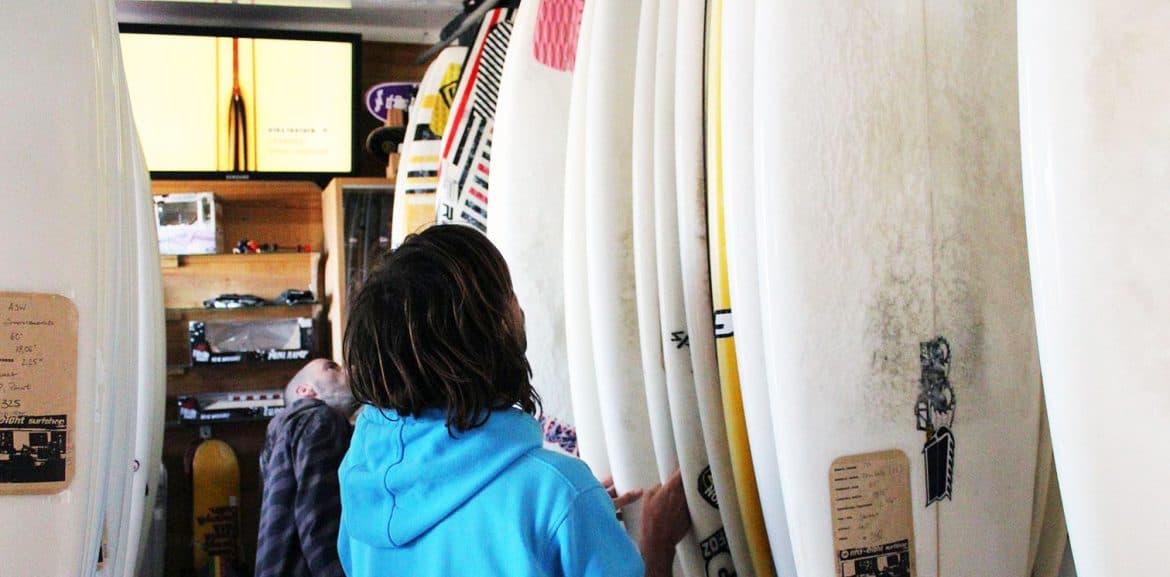
wat like get smoked
Can you please get more information on the mini mal
You should include “fish” which by a purists definition has twin keels (large 6-12 inch fins) , is less than 6’2 and a wide swallow tail at least 11 inches wide. Best ridden on long walling small to medium waves, although popular in small junky waves due to their speed. A great alternative to a mini mal as its easier to whip around and gain speed although not as manouverable as a shortboard.
I have a surfboard from Toros surfshop in california….It is a minigun Model 2015….It is 6ft 6inches long with a single fin and sunburst finish…I would like to find out if their is a market for this type of board and if so, what is it valued at from least amount to the most
can sum1 plz help me with my school project. i have to find the size and the makings of a fibreglass long-board and a thruster. can u plz help me?:(
Sweet :)
What about a beater board?
Good point, I’ll add it soon :)
I disagree on the surf mat paragraph, you describe it as some kind of pool toy for lazy people. Check out some surf mat videos (george greenough for example), you will see that they are great surfcrafts. They are fast, they require great balance and control, riding a surf mat is actually closer to bodysurfing than bodyboarding. They ride at their best uninflated enough to be bendable at 90°. Meaning they are not stiff at all, that explains why learning the surf mat is quite difficult, even for experimented surfers, because it is completely different. No leverage effect to turn, it is more about balancing and “shaping” the inside rail in real time by squeezing the outside rail, when it is needed. On flat sections, you release the pressure to gain speed. I used to bodyboard, then I switched to the mat and I had to re learn everything, from the take off to the turn. But now I can enjoy great fast rides. I also ride plywood paipos. Just so you know they are not “lightweight boogie-boards”, they are are actually heavier (at least the classic 60’s plywood paipos). But they are fast, that’s true. Without the foam you feel the wave better.
Hey Tom, thanks for your info. I’ve never ridden a mat.
Why the rip on bodyboarding?…
Very nice article to know all the types of boards. Very useful mates :)